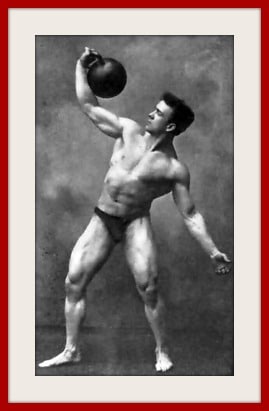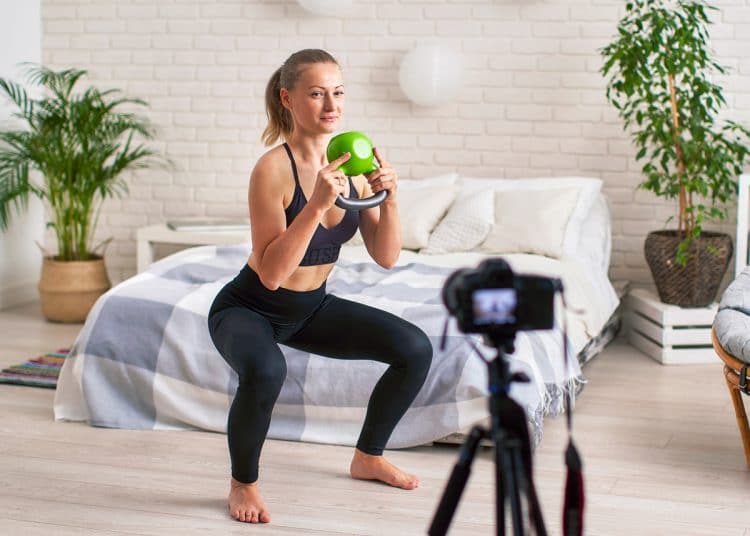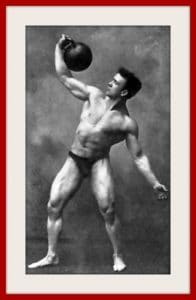Kettlebells have been around for hundreds of years and, depending on who you believe, originate in Russia, the Nordic countries, or Scotland. For most of the 20thcentury, kettlebells were something of a fringe training tool but, with the rise of CrossFit and functional training, they became popular again.
For the uninitiated, kettlebells are spherical weights with a handle on top. They can be used with one or two hands for a wide range of upper and lower body exercises. Most kettlebells come in fixed weights, and they can be used singularly or in pairs. Kettlebells can be lifted, pressed, pulled, swung, and even thrown.


On the downside, and despite their simplicity, kettlebells are often expensive. That’s probably due to their popularity. Because of this, a lot of exercisers are limited to buying just one or two kettlebells.
This means that a lot of people find themselves doing just a few kettlebell exercises, and many focus almost exclusively on swings. That’s a shame because, even if you only have a single kettlebell, you can still train your entire body!
In this article, we’re proud to present the Fitness Volt One Kettlebell Workout!
The One Kettlebell Workout
As the name suggests, all you need for this workout is a single kettlebell. You don’t even need a training bench. The weight of your kettlebell isn’t all that important either because you’re going to do each exercise to failure. So, if you’ve got a light kettlebell, you’ll end up doing more reps and fewer reps if you’ve only got a heavy kettlebell.
You’ll also find that your reps vary from exercise to exercise, as some are harder than others. Just do as many reps as possible (AMRAP), and you’ll overload your muscles and get great results.
Regarding rest periods between sets, that depends on the weight of your kettlebell and how many reps you manage to pump out. If you can do high-rep sets, short rests are more appropriate, e.g., 30-45 seconds. But, if your kettlebell is heavy and your reps are low, longer rests are the way to go, e.g., 2-3 minutes.
Finally, do two to five sets of each exercise. Adjust your training volume according to how you feel. Do as many sets as you need to fatigue the muscles you’re working on. You don’t have to do the same number of sets for every exercise. For example, you may want to do more sets for your legs.
Because this workout involves all your major muscles, you only need to do it 2-3 times per week on non-consecutive days, such as Monday and Thursday, or Monday, Wednesday, and Friday. This allows plenty of time for rest and recovery.
Warming up
Get more from your workout and reduce your risk of injury by warming up before you begin. Do 5-10 minutes of light cardio (e.g., jumping rope or jogging) followed by some dynamic stretches and joint mobility exercises. Spend extra time on any joints that feel stiff.
The workout
- Goblet squats
- Single-leg Romanian deadlifts
- Single-arm floor press
- Single-arm bent-over rows
- Half-kneeling single-arm overhead press
- Reverse lunges
- Halos
- Towel biceps curls
- Get-ups
- Reverse crunches
You can also do this work out as a circuit. Instead of doing several sets of each exercise before moving onto the next, just do one set of each back-to-back. Rest 1-2 minutes after exercise number ten, and then do another lap. Circuit training turns a strength workout into a fat-burning, fitness-building cardio workout.
Exercises:
Get the most from this workout by doing all the exercises correctly. This will make your workout safer AND more effective. Improper exercise form often puts stress on the wrong muscles and joints and could also cause muscle or joint injuries.
1: Goblet squats

 Goblet squats work your quadriceps, hamstrings, and glutes. They’re easier on your lower back than barbell back squats, as they promote a more upright torso. Make sure that you brace your core to stabilize your spine and squat as deep as you can without rounding your lower back or hurting your knees.
Goblet squats work your quadriceps, hamstrings, and glutes. They’re easier on your lower back than barbell back squats, as they promote a more upright torso. Make sure that you brace your core to stabilize your spine and squat as deep as you can without rounding your lower back or hurting your knees.
Check out our in-depth guide to learn how to do goblet squats correctly.
2: Single-leg Romanian deadlifts
The Romanian deadlift is one of the best posterior chain exercises around. Working your glutes, hamstrings, and lower back, this is an important exercise for better posture and improved athleticism. Working one leg at a time helps fix left-to-right strength imbalances and will also develop your balance and coordination.
How to do it:
- Hold your kettlebell in your left hand and shift your weight over onto your right foot. Brace your abs and pull your shoulders down and back.
- With your supporting knee slightly bent but rigid, hinge forward from your hips and lower your kettle down toward the floor. Extend your opposite leg out behind you as a counterbalance.
- Stand back up and repeat.
- Try to do the same number of reps on both legs.
3: Single-arm floor press
Floor presses are an excellent alternative to bench presses. Working your chest, shoulders, and triceps, floor presses are generally easier on your joints. Using a single kettlebell means you can do this exercise on your own, as you can use your free hand for spotting.
How to do it:
- Lie on the floor and hold your kettlebell above your shoulder with your arm straight. Use a neutral grip, so your palm faces inward. Brace your abs and pull your shoulders down and back. Your legs can be bent or straight as preferred.
- Bend elbow and lower the kettlebell until your upper arm lightly touches the floor. Keep your arm close to your side.
- Drive the weight back up and repeat.
- Try to do the same number of reps on each side.
4: Single-arm bent-over rows
The single-arm bent-over row works your lats, mid-traps, and rhomboids, as well as your biceps and forearms. Normally done with your free hand on a bench for support, you can also do bent-over rows without a bench. This means your core and lower back will get a workout too.
How to do it:
- Hold your kettlebell in your left hand. Step forward with your right leg and lean forward, placing your right hand on your right knee. Pull your left shoulder down and back and brace your core. Do not round your lower back.
- Bend your arm and pull the kettlebell up and into your ribs. Keep your wrists straight and your upper arm close to your side.
- Extend your arm and repeat.
- Do the same number of reps on both sides.
5: Half-kneeling single-arm overhead press
Before the 1950s, most pressing exercises were done overhead. That’s because the bench press as we know it had not been invented. Overhead pressing works your shoulders and triceps, and using just one kettlebell means your core gets a good workout too. This half-kneeing variation stops you from using your legs to cheat the weight up and also helps take pressure off your lower back.
How to do it:
- Adopt a half-kneeing position with your left leg forward. Make sure your front shin and rear thigh are both vertical. Hold your kettlebell in your right hand next to your right shoulder. Brace your core and pull your shoulder down and back.
- Extend your arm and press the weight up and overhead to arms’ length. Keep your core tight, and your hips and shoulders level throughout.
- Lower the weight back to your shoulder and repeat.
- Do the same number of reps on each arm. Swap legs when you change arms.
6: Reverse lunges
Lunges are an excellent lower body exercise. Working one leg at a time, lunges target your quads, hamstrings, and glutes, as well as your abductors and adductors. They’re useful for developing hip mobility and fixing any left-to-right strength imbalances. Lunges are an especially good strength training exercise for runners. Reverse lunges are generally more knee-friendly than forward and walking lunges.
How to do it:
- Rack and hold your kettlebell on one shoulder. Tuck your elbow into your side, pull your shoulder down and back and brace your abs. Stand with your feet together.
- Take a large step back, bend your legs, and lower your rearmost knee down toward the floor.
- Push off your back leg and return to your starting position.
- Do your next rep with the opposite leg.
- Alternate legs for the duration of your set.
- Hold the weight on the opposite side for your next set.
7: Halos
Halos work all three deltoid heads, your upper and mid-traps, biceps, and triceps, and will also help mobilize your thoracic spine and shoulder joints. Done with a light kettlebell, this is a very useful upper body warm-up exercise but, with a heavier weight, this is a serious shoulder builder.
How to do it:
- Hold your kettlebell upside down in front of your chest by the vertical handles. Brace your abs, pull your shoulders down and back, and bend your legs slightly for balance.
- Circle the weight around your head, behind your neck, and then back in front of your face. The kettlebell should stay very close to your head.
- Do not move your head. Instead, move the weight around your head.
- Reverse directions and repeat.
8: Towel biceps curls
This exercise works your biceps, brachialis, and forearms, making it a time-efficient and functional arm exercise. All you need is your trusty kettlebell and a standard gym towel.
How to do it:
- Thread your towel through the handle of your kettlebell. Hold one end in each hand, gripping the towel tightly. Stand with your feet shoulder-width apart, core braced, and shoulders down and back.
- Starting with your arms straight, bend your elbows and curl your hands up to your shoulders. Keep your upper arms close to your ribs.
- Lower the weight and repeat.
9: Get-ups
The get-up, also known as the Turkish get-up, is a total body exercise that develops strength, stability, and mobility all at the same time. A high-rep set of get-ups will also drive your heart rate sky-high.
This exercise can be hard to master initially, so take it slow and feel free to do it without weight until you can perform it correctly.
Learn how to do Turkish get-ups here.
10: Reverse crunches
Contrary to popular opinion, reverse crunches DO NOT work your lower abs; there is no such muscle! Instead, when you do reverse crunches, you’ll be lifting your hips up toward your shoulders and not your shoulders toward your hips. This movement involves your rectus abdominis, which is the long, flat muscle on the front of your abdomen. You may also feel this exercise in your hip flexors.
How to do it:
- Place your kettlebell on the floor and lie down, so it’s just behind your head. Grip the handles firmly. Bend your legs so that your knees are directly over your hips. Brace your abs.
- Slowly curl your lumbar spine, lifting your butt and lower back off the floor. Roll your hips up toward your shoulders.
- Return to the starting position and repeat.
Wrapping Up
Fitness and exercise are often portrayed as very complicated subjects, but they don’t have to be. In fact, you can have a great workout using nothing more than a few bodyweight exercises or a single kettlebell. Providing that you work hard enough, your muscles will adapt to your workout and get stronger.
You can do this workout at home, at the gym, or even outdoors. All you need is one kettlebell. No kettlebell? No problem! You can do this workout using a single dumbbell too.
Don’t let a lack of training equipment stop you from reaching your fitness goals. Ultimately, the effort you put in is much more important than the tools you use.

